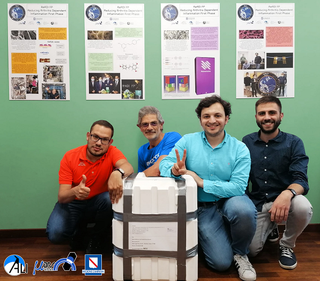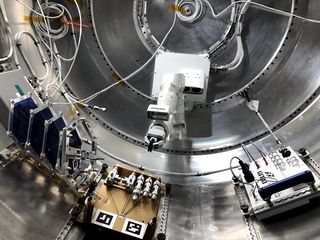SpaceX Dragon to launch big science haul to space station for astronaut health, plant stress and more
Find out what's on board SpaceX's Dragon CRS-23 cargo mission to the International Space Station.
Update for 3:32 a.m. ET: Saturday's planned launch of the SpaceX Dragon CRS-23 mission has been scrubbed due to weather. The next available launch opportunity is on Sunday (Aug. 29) at 3:14 a.m. EDT (0714 GMT). Read the full story.
CAPE CANAVERAL, Fla. — The next SpaceX resupply launch to the International Space Station, scheduled for Saturday (Aug. 28), will carry a bevy of science payloads to the astronauts living and working on the orbiting laboratory.
The robotic flight, called CRS-23, marks the 23rd mission for SpaceX under its commercial cargo resupply services contract with NASA. The launch is scheduled for 3:37 a.m. ED (0737 GMT) from NASA's Kennedy Space Center in Florida, and you can watch the action live here at Space.com, courtesy of NASA. You can also watch directly via NASA TV or SpaceX.
The upgraded Dragon cargo capsule that will launch atop a veteran SpaceX Falcon 9 rocket is filled with 4,800 pounds (2,177 kilograms) of supplies and science investigations. The research gear will support a variety of experiments in the life sciences, pharmaceuticals, and many other fields.
"We're really excited to partner with SpaceX for this mission," Joel Montalbano, NASA's ISS program manager said Friday (Aug. 27) during a prelaunch news conference. "We're using these [resupply] missions to optimize the science and utilization that we do on board space station, as well as increasing the amount of exploration, technology development we can do to support us for future missions."
Video: SpaceX CRS-23 mission to space station - Science payloads explained
Related: You can watch a SpaceX Dragon launch NASA cargo to the space station early Saturday. Here's how.

Saturday's flight will mark the third time SpaceX's upgraded Dragon spacecraft will carry cargo. The vehicle is a modified version of the Crew Dragon spacecraft that lacks the systems necessary for human missions, such as seats, cockpit controls and a life-support system, as well as the SuperDraco thrusters that provide a special emergency escape system that's only used if a problem occurs during launch.
Get the Space.com Newsletter
Breaking space news, the latest updates on rocket launches, skywatching events and more!
Through their commercial partnerships, Space and NASA have been working to bring more science to the space station. And this upgraded cargo capsule is one way, as it allows more scientific cargo to ride skyward than its predecessor.
The Dragon's interior can now support more powered payloads, which is a huge benefit for the life sciences as it allows for more cold storage and other types of investigations. It also allows for the crew to store some of the powered payloads onboard Dragon while the craft is on orbit.
Engineering plants for future space food

When astronauts embark on long-duration missions in the future, crews will need to grow food to supplement the supplies they bring with them. However, microgravity stresses out plants.
A new investigation, called APEX-08, will help determine the effect of plant stress responses to the microgravity environment. As part of the experiment, researchers will grow Arabidopsis thaliana, a type of thale cress plant that scientists routinely use for research.
The study includes genetic alterations, or mutants, that elicit a response in the pool of polyamines — a group of organic compounds that regulate how a plant responds to environmental stress.
"This experiment will test a range of genotypes of Arabidopsis plants for modified abilities to respond to the microgravity environment," Dr. Patrick Masson, principal investigator, University of Wisconsin-Madison, said during the prelaunch briefing. "We altered a polyamine metabolic pathway previously implicated in plant stress responses, and we'll look for variations in growth and alterations in gene expression profiles between genotypes."
Previous research indicates that polyamines in plants, particularly a major group called putrescines, could be manipulated — both in space and on the ground — to reduce stress reactions. Masson, along with co-investigator Dr. Shih-Heng Su, are sending six distinct genotypes of Arabidopsis plants for the study.
The plant seeds will be sent up to the ISS on plant plates and photographed before being installed in the Veggie growth chamber. After nine days, astronauts will remove the plants, photograph their growth, and then preserve them for shipment back to Earth.
Masson says that by comparing the samples from the space station with an identical control experiment on the ground, that the team will have a good understanding of how altering the putrescine within the seedlings can affect how the plants respond to the stress of microgravity.
The results could have implications for farming here on Earth, as scientists could engineer plants to better withstand environmental stressors, like drought.
Astronaut vision

Another payload will look at a new way of measuring changes in astronaut vision. More than two-thirds of astronauts experience abnormal vision changes while in space, an issue that scientists are trying to better understand.
Claudia Stern, an ophthalmologist and flight surgeon for the German Aerospace Center, is spearheading a new device that will help take better measurements of changes in astronaut vision while in orbit.
Many of these changes are seen in the retina, the region in the back of the eye that connects the eye to the brain. To monitor these changes, expensive bulky scanners were sent to the space station. The new device, called Retinal Diagnostics, is much more compact.
It uses a commercially available ophthalmology lens that has been approved for routine clinical use with mobile devices to capture images of the human retina in space. The images will be used to detect vision changes common among astronauts.
The lens can clip onto a mobile device camera to capture video images of an astronaut's retina during spaceflight. Astronauts will test them out and beam both photos and video back to the ground. The data collected will help train diagnostic models to detect retinal pathologies common among astronauts. This way astronauts who are far from home can self-diagnose.
It not only has implications for long-duration space travel, especially on vehicles where space is more limited but also here on Earth in remote regions that may not have access to specialized equipment. The device is made with commercially available lenses, making it more cost-effective.
Bone health
What does wine have to do with bone health? Common waste products leftover after producing wine could help treat osteoporosis according to a research team out of Naples, Italy.
A group of biologists, led by Dr. Fabio Peluso, are sending stem cells to the ISS as part of an experiment that looks at bone regeneration in microgravity. The study aims to determine if a mixture of collagen and metabolites from grapes can help repair bones.
REducing Arthritis Dependent Inflammation First Phase (or READI FP) will look at how microgravity and space radiation affect the generation of bone tissue. As well as the potential protective effects of bio-collagen and bioactive metabolites such as antioxidants during spaceflight.
Related: Buff space mice could stop astronauts from losing bone and muscle mass

The team is sending stem cells in Petri dishes up to the ISS, where they will be treated with biological stimulants in order to form cells like osteoblasts (bone cells). A mixture of collagen and metabolites, such as antioxidants, polyphenols, anthocyanins — extracted from grape skins and other wine waste products — will be added to the mix to study their effects on cell growth in microgravity.
Researchers think that these compounds will aid in bone growth and could be used to help create new drugs and therapies for diseases like osteoporosis here on Earth.
Cubesat collection
A bevy of cubesats, which are small satellites about the size of a loaf of bread, are headed to the space station. NASA is partnering with Nanoracks, who will deploy the cubesats in early October to begin their missions.
One of which is called PRCuNaR2 and is Puerto Rico's first satellite. The project, which has been in the works for more than 13 years, will finally make it to space on Saturday.
Designed by Dr. Amilcar Rincon-Charris and his students at the International American University in Puerto Rico, the experiment looks at how particles coalesce in space. The research has implications to better understand the formation of structures like Saturn's rings as well as planetary bodies.
The small satellite is divided into nine chambers, with different materials inside. Once deployed from the ISS, the particles will be allowed to float about and combine with each other. Through photos and videos collected by the satellite's onboard cameras, researchers at the university will be able to examine the collisions between the particles in detail.
Robots in space
Nanoracks is partnering with GITAI robotics of Japan to send a new robotic arm to the space station. The company will test out the dexterity and maneuverability of a robotic arm inside the Bishop Airlock, which is currently attached to the space station.
The new arm is a technology demonstration mission that will have the robot perform routine tasks on station that an astronaut would normally do. It's roughly the size of a human arm and will be doing things like flipping switches, turning knobs, and more.

But that's not all. The robot will also handle small parts and put them together to build a larger assembly, much like a solar panel. This task will be completely autonomous with ground controllers monitoring it to assist in the event of any unexpected anomalies. For the more routine tasks, operators on the ground will both monitor and tele-operate the arm.
"Ten years from now, we foresee our robots working on the moon," Toyotaka Kozuki, chief technology officer of GITAI, Inc. told Space.com. "Helping with exploration, mining, and even building the first human habitats. This is the first big step towards that."
Follow Amy Thompson on Twitter @astrogingersnap. Follow us on Twitter @Spacedotcom or Facebook.
Join our Space Forums to keep talking space on the latest missions, night sky and more! And if you have a news tip, correction or comment, let us know at: community@space.com.

Amy Thompson is a Florida-based space and science journalist, who joined Space.com as a contributing writer in 2015. She's passionate about all things space and is a huge science and science-fiction geek. Star Wars is her favorite fandom, with that sassy little droid, R2D2 being her favorite. She studied science at the University of Florida, earning a degree in microbiology. Her work has also been published in Newsweek, VICE, Smithsonian, and many more. Now she chases rockets, writing about launches, commercial space, space station science, and everything in between.
